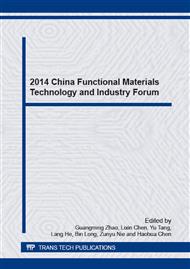p.451
p.459
p.464
p.471
p.477
p.485
p.493
p.500
p.503
The Effect of Phosphatic Composite on Magnesium Phosphate Cement Performance
Abstract:
The capacity of 10%, 30%, and 50% ammonium dihydrogen phosphate were replaced with an equal amount of three phosphate (potassium dihydrogen phosphate, sodium dihydrogen phosphate, disodium hydrogen phosphate) respectively. Magnesium phosphate cement was made by phosphate of replaced, which strength, setting time, fluidity, hydration temperature, and the hydration products was researched. The results show that: MPC was made that replaced with the equal amount of three kind of phosphate, which has good mechanical properties. Setting time and fluidity change along with the replacment. Three kind of phosphate replace ammonium dihydrogen phosphate, which change the hydration process of MPC. When ammonium dihydrogen phosphate was replaced by an equal amount of disodium hydrogen phosphate, the temperature of hydration is only 69.4 °C. XRD showed that the diffraction peaks of composite’s magnesium phosphate cement increases.
Info:
Periodical:
Pages:
477-484
Citation:
Online since:
December 2014
Authors:
Keywords:
Price:
Сopyright:
© 2015 Trans Tech Publications Ltd. All Rights Reserved
Share:
Citation:


